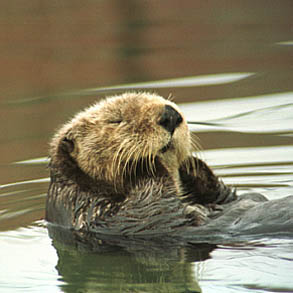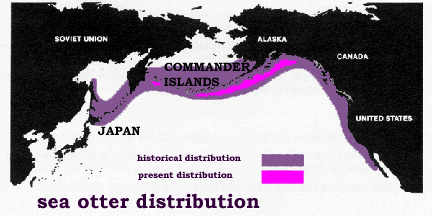|
California
Sea Otters
|
|
 |
|
|
It is not uncommon to see these playful animals lying on their backs and floating around Avila bay. In the past few years their sightings have increased according to local college students who visit the bay frequently. There has been no hands on research planned for the California sea otter due to the U.S. Marine Mammal Protection Act, but further research on the species itself is possible. Scientific Classification
Physical Characteristics Male California sea otters reach sizes up to 4 feet in length and 64 pounds while females are a little bit smaller reaching lengths up to 3.5 feet and 44 pounds. Sea otters have small dexterous forefeet with retractive claws. They use these feet for grooming, finding food, and eating, but not for swimming. Their flipper-like hind feet are large, broad, and webbed and propel them through the water. The outer digits of their hind feet are the longest. A sea otter's nose pad is large, bare, black, and diamond shaped. An adult female's nose pad often bears pink scars from wounds incurred during mating, when the male grasps her nose with his teeth. The fur of the sea otter is the densest of any mammal. Highest density occurs on the forearms, sides, and rump; lowest density occurs on the chest, legs, and feet. The average density is about 650,000 hairs per square inch. A single large male may have over 800 million hair fibers covering its body. Behavior All otters must continually groom their fur to maintain its insulating qualities. Researchers have observed sea otters spending at least 11% to 48% of their day grooming. They use their paws and claws to remove debris and comb their fur. They may also aerate their fur by blowing air into it and beating the water with their feet to whip it into foam. An otter's flexible body and loose-fitting skin allow it to reach every part of its fur. Sea otters are basically solitary. Males and females occupy separate sections of the coastline, and only come together briefly for mating. Males do not exhibit strong territorial behavior and do not drive other males away when in female territories. Sea otter's scent is the most important sense for communication. Each otter's character scent is as unique as a fingerprint, and conveys such information as identity, age, sex, and breeding condition. Conservation Issue Similar to all other mammals, California sea otters are protected by law. The U.S. Marine Mammal Protection Act of 1972 made it illegal to hunt or harass any marine mammal in U.S. waters. The primary objective of the MMPA is to maintain the health and stability of the marine ecosystem and to maintain an optimum population of marine animals.
|

